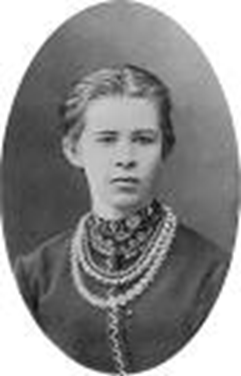 |
| Front |
Lesya
Ukrainka
Lesya Ukrainka's real name is actually Larysa Petriva. She
was a poet, writer and the only woman to have her picture on a Ukrainian bill
of money. Her picture was also put on a stamp and coin. She knew Russian,
Polish, German, Bulgarian, English, French, Italian, Latin, Greek and of course
Ukrainian.
Lesya was born in Novohrad-Volynskyi, in the Russian Empire,
on February 25 1871. Her mother was a Ukrainian writer, publisher and poet. Her
father was a well-known Ukrainian scientist, historian, folklorist and a public
figure. Lesya was very much like her father, she was tall and had his eyes,
build and features. Lesya and her siblings were home schooled by Ukrainian
tutors. Her parents had them taught this way to avoid the schools that taught
and used only the Russian language. Lesya wrote her first poem at age eight, it
was called, Hope. She wrote it because her aunt had taken a political move
against the Tsarist autocracy and she was arrested and exiled. Later on that
year, Lesya and her entire family moved to Lutsk where her father started
building houses for another family in a village nearby. Her uncle, Mykhaylo
Drahomanov, encouraged Lesya to learn Ukrainian folk songs, Ukrainian stories
and the history of Ukraine, as well as, the Bible because of it inspiring
poetry and eternal themes.
Lesya's first published poem was called Lily of the Valley
and her first collection of poetry was published in1893. It was called On the
Wings of Songs and was smuggled into Kiev because books written in Ukrainian
language were forbidden in the Russian Empire. While she was being treated for
sickness, she met an official officer, Serhiy Merhzynsky. Although they fell in
love they did not marry. Serhiy died on March 3 1901 at Lesya's bedside. That
night she wrote the entire dramatic poem of Oderzhyma at his deathbed. Lesya
translated the Communist Manifesto into Ukrainian in 1902 and the tsarist
police arrested her soon after. After she was released she was put under
surveillance. Lesya married a court official in 1907, Kyment Kvitka. They moved
to Crimea and then to the country of Georgia.
Lesya died on August 1, 1913 and was buried in Kiev. Since
most bills of money have pictures of men on them I was very surprised when I
found out that a female is on the Ukrainian 200 hryvna bill. I like Lesya and
her family because they were not afraid to oppose the Communists, like when
Lesya translated the Communist Manifesto and her aunt took a daring move
against the tsarist autocracy.
Here is an example of Lesya's Poetry:
Thoughts, away, you heavy clouds of autumn!
For now springtime comes, a
gleam with gold!
Shall
thus in grief and wailing for ill fortune,
All the tale of my
young years be told?
No, I want to smile through tears and weeping,
Sing my songs where evil holds
its sway,
Hopeless, a steadfast hope forever
keeping, I want to live!
You, thoughts of grief,away!
~~~~~~~~~~~~~~~~~~~~~~~~~~~~~~~~~~~~~~~~~~~~~~~~~~
 |
| Back |
Lubart Castle
The Lubart Castle is also known as the Lutsk Castle, because
it is in the city of Lutsk in western Ukraine.
It is one of the oldest castles in Europe and the main tower is almost
one hundred feet tall and thirty feet thick
walls connect the castle's three towers.
The Lubart Castle was built in
1340 by Prince Lubart of Lithuania on the same location of the wooden fortress
that Prince Volodmyr the Great ordered to be
built. Prince Lubart built this castle with stones and made it his
home. Later on the castle's stone walls
were covered with bricks to make it look fancier which should explain why the
castle walls are so thick. Even though the castle went through 600 years of attacks
it is still in great shape, good enough shape for the festivals and ceremonies
that are done at the castle. In 1429
many rulers from other nations met at this castle to discuss how to keep the
Turks from taking over Europe. This
place is where the idea of the European nations to work together was first
discussed. The funny thing is that,
although most of these European nations are now part of the European Union,
Ukraine, where the idea first came up, is still not
Even though not all Ukrainians go to visit the Lubart Castle
they see it almost every day on the back of the two hundred hryvnia Ukrainian
bill.
The White Stork






